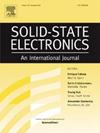通过栅极电容评价不同漏极偏压无结纳米线晶体管的有效沟道长度
IF 1.4
4区 物理与天体物理
Q3 ENGINEERING, ELECTRICAL & ELECTRONIC
引用次数: 0
摘要
本文通过三维数值模拟分析了在不同漏源极电压下,无结纳米线晶体管(JNT)的有效通道长度(LEFF)与器件的栅极电容(CGG)之间的关系,并与理论方法进行了比较。在这种情况下,对于高VDS偏置(在0.5 V和1 V之间),通过CGG曲线存在交叉现象,这表明了JNTs的掐断状态。通过外推掐断状态下的栅极电容作为器件通道长度(LMASK)的函数来提取LEFF,对于具有横向间隔和不同掺杂浓度的结构,对于不同的LMASK和源极和漏极长度(LSD), LEEF增加约6 nm,并与VDS偏置和掺杂浓度有关。最后,与理论方程进行了比较,表明该方法可以很好地提取甚至估计实验器件的有效信道长度。本文章由计算机程序翻译,如有差异,请以英文原文为准。
Evaluation of the effective channel length of Junctionless nanowire transistors with different drain bias through the gate capacitance
This paper analyzes through 3D numerical simulations the effective channel length (LEFF) of Junctionless Nanowire Transistors (JNT) through the gate capacitance (CGG) of the devices for different drain-to-source voltages (VDS) and compares the results with a theoretical approach. In this case, there is a phenomenon of intersection through the CGG curves for high VDS bias (between 0.5 V and 1 V) that indicates the pinch-off regime of the JNTs. The LEFF extraction has been done from the extrapolation of the gate capacitance in the pinch-off regime as a function of the device’s channel length (LMASK), for different LMASK and source and drain lengths (LSD) for structures with lateral spacer and different doping concentrations, showing that LEEF increases ∼ 6 nm and presents a relationship with VDS bias and doping concentration. Finally, one comparison with the theoretical equation was done, showing that the method is a good way to extract or even estimate the effective channel length of the experimental devices.
求助全文
通过发布文献求助,成功后即可免费获取论文全文。
去求助
来源期刊

Solid-state Electronics
物理-工程:电子与电气
CiteScore
3.00
自引率
5.90%
发文量
212
审稿时长
3 months
期刊介绍:
It is the aim of this journal to bring together in one publication outstanding papers reporting new and original work in the following areas: (1) applications of solid-state physics and technology to electronics and optoelectronics, including theory and device design; (2) optical, electrical, morphological characterization techniques and parameter extraction of devices; (3) fabrication of semiconductor devices, and also device-related materials growth, measurement and evaluation; (4) the physics and modeling of submicron and nanoscale microelectronic and optoelectronic devices, including processing, measurement, and performance evaluation; (5) applications of numerical methods to the modeling and simulation of solid-state devices and processes; and (6) nanoscale electronic and optoelectronic devices, photovoltaics, sensors, and MEMS based on semiconductor and alternative electronic materials; (7) synthesis and electrooptical properties of materials for novel devices.
 求助内容:
求助内容: 应助结果提醒方式:
应助结果提醒方式:


